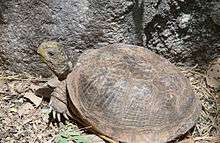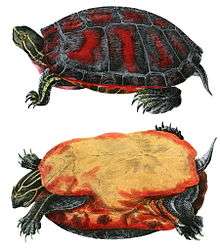Desert box turtle
| Desert box turtle | |
|---|---|
 | |
| Scientific classification | |
| Kingdom: | Animalia |
| Phylum: | Chordata |
| Subphylum: | Vertebrata |
| Class: | Reptilia |
| Order: | Testudines |
| Family: | Emydidae |
| Genus: | Terrapene |
| Species: | Terrapene ornata |
| Subspecies: | Terrapene ornata luteola |
| Trinomial name | |
| Terrapene ornata luteola H.M. Smith & Ramsey, 1952 | |
| Synonyms[1] | |
| |
The desert box turtle (Terrapene ornata luteola) is a subspecies of box turtle which is endemic to the southwestern United States and northern Mexico.
Geographic range
It ranges from the Trans-Pecos region of Texas, New Mexico, and southeastern Arizona in the United States, south into Sonora and Chihuahua in Mexico.
Habitat
It lives in arid, open prairie areas.
Diet
It is an omnivore, eating native vegetation, insects, and sometimes carrion.[2]
Description
All box turtles have a distinctive hinged lowered shell (the box) that allows them to completely enclose themselves. The desert box turtle lacks the raised carapace keel of the Eastern Box Turtle, and its colors are muted for camouflage in the desert. The colors of the mature turtles are lighter and more muted than the colors of the young. Most, but not all, male turtles have red irises. Other characteristics of males include concave plastrons, thicker tails with the cloaca nearer the tip, and longer rear legs with larger, curved inside claws which are used to grip the female shell during mating.
Hibernation
Desert box turtles hibernate in the winter, emerging in April to begin searching for a mate.
Reproduction
Nesting takes place from May to July. Clutch size ranges from two to eight eggs, and incubation lasts about seventy days.[2] They can live 25 years or more.
Males are normally sexually mature by 8–9 years of age, but in captivity have been known to breed as young as age 2. Females normally require 10–11 years to reach sexual maturity. Their breeding season lasts between March and May, and nesting sites will be chosen from June to July. Males will be sexually active from the time they emerge from hibernation until September or October. Males often fight aggressively with other males over females when looking for a mate.
References
- ↑ Fritz, Uwe; Peter Havaš (2007). "Checklist of Chelonians of the World". Vertebrate Zoology. 57 (2): 201. Archived from the original (PDF) on 2010-12-17. Retrieved 29 May 2012.
- 1 2 Desert Box Turtle. Terrapene ornata luteola. Pima County Species Fact Sheet.
External links
| Wikispecies has information related to: Desert box turtle |
| Wikimedia Commons has media related to Terrapene ornata. |
- ITIS Standard Report Page
- Information from the Arizona Sonoran Desert Museum
- Closeup photo of four-year-old male Desert Box Turtle
